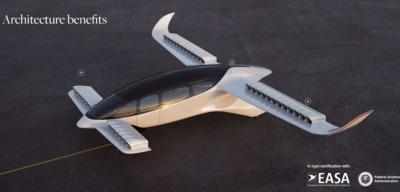Ostensibly …

The global market for electric aircraft is estimated to be $7.9-billion in 2023 and is projected to reach $27.7-billion by 2030 at a Compounded Annual Growth Rate (CAGR) of 14.8-percent during the forecast period. The market’s growth is driven primarily by the deployment of Urban Air Mobility (UAM) aircraft and the increasing use of electric aircraft for cargo applications and commercial aerial mission-specific activities.
Among the most prolific and profitable producers of electric aircraft are:
- Airbus, which in 2010 developed CriCri, the world’s first all-electric, four engine aircraft. In the years since, the consortium has made significant progress in the electrification of flight. Airbus’s all-electric, twin-propeller E-fan aircraft successfully crossed the English Channel in 2015, and the company’s electric Vertical Takeoff and Landing (eVTOL) demonstrator projects, Vahana and CityAirbus, have completed rigorous and comprehensive flight-testing programs. Airbus has also successfully developed the world’s first solar-electric high-altitude platform station, Zephyr, a gossamer contraption capable of flying continuously for months on end at altitudes of 70,000ft—well above weather and conventional air traffic.
- Elbit Systems LTD, an international technology concern about the business of developing and supplying a portfolio of airborne, land, and naval systems and products for defense, homeland security, and commercial aviation applications. The company’s Unmanned Aircraft System (UAS) design is based on decades of operational experience and is in service with numerous worldwide military and security forces. Elbit System’s UAS factors prominently in the Intelligence, Surveillance, and Reconnaissance (ISR) capabilities of the Israel Defense Forces (IDF). What’s more, the company’s experience and innovative approach to UAS development, production, fielding, and support have occasioned outstanding UAS performance and highly effective UAS operations around the globe.
- Aerovironment, Inc. a designer, developer, producer, supporter, and operator of numerous UAS and tactical missile products and services for government agencies, businesses, and consumers. The company’s UAS platforms facilitate situational awareness, multi-band communications, force protection, and similarly critical augmentations to military and civilian missions. Aerovironment supplies UAS, tactical missile systems, and related services primarily to organizations within the U.S. Department of Defense (DoD). The company provides intelligent, multi-domain robotic systems ranging from small and medium unmanned aircraft systems to full tactical missile arrays.
The use of all-electric aircraft has been and will likely continue to be driven by growing environmental consciousness. The logistics sector has fretted protractedly over CO2 emitted from cargo aircraft, and is ostensibly committed to achieving zero-emissions by 2050. Stakeholders in the sector are investing in electric modes of transportation by which to reduce the logistics industry’s carbon footprint. The gradual conversion to all-electric aircraft opens new avenues and opportunities for the manufacturers of such machines.
The global volume of air freight has increased significantly since the turn of the millennium, reaching 55.9-million-metric-tons in 2020. The global volume of air freight is expected to increase commensurately with the rise of e-commerce.

Among the most significant challenges faced by electric aircraft manufacturers is the low energy-density of extant batteries. Existing lithium-ion batteries have a mean energy-density of approximately 250-watt-hours-per-kilogram (Wh/kg)—a figure dramatically inferior to the mean 12,000 Wh/kg energy density of conventional jet fuel. All told, conventional fossil-fuels are some 14-times more energy-rich than battery-powered alternatives. Ergo, long-haul all-electric commercial flights remain the province of future generations.
To approximate the range of conventional jet aircraft, electric aircraft would need be equipped with batteries weighing thirty-times more than an energy-equivalent load of jet-fuel.
Advancements such as lithium-sulfur batteries have increased mean battery energy density to 500 or 600 Wh/kg. However, a contingent of industry experts contends that batteries capable of powering economically viable all-electric commercial aircraft will not be available until the late 2030s or early 2040s.
Nevertheless, DHL Express, in August 2021, ordered 12 electric cargo aircraft from start-up Eviation for delivery by 2024. So provisioned, DHL intends to build the world's first electric air cargo network.
Also in 2021, Archer Aviation, Inc. announced its intentions to work with REEF—the U.S. and Canada’s largest operator of parking facilities and logistics hubs—to develop urban takeoff and landing sites. REEF’s network lends itself to Archer’s plans to salt dense urban areas with vertiports. Thus afforded proximity to high-traffic city hubs, Archer plans to establish a UAM network and populate such with its eVTOLs.
Finally, Lilium GmbH, in 2021, partnered with Customcells—a German manufacturer and supplier of battery cells to international aviation, automotive and military customers—to act as Lilium’s prime supplier of lithium-ion batteries for its seven-seat Lilium Jet.
 ANN's Daily Aero-Term (04.25.24): Airport Rotating Beacon
ANN's Daily Aero-Term (04.25.24): Airport Rotating Beacon ANN's Daily Aero-Linx (04.25.24)
ANN's Daily Aero-Linx (04.25.24) Klyde Morris (04.22.24)
Klyde Morris (04.22.24) Airborne 04.24.24: INTEGRAL E, Elixir USA, M700 RVSM
Airborne 04.24.24: INTEGRAL E, Elixir USA, M700 RVSM Airborne 04.22.24: Rotor X Worsens, Airport Fees 4 FNB?, USMC Drone Pilot
Airborne 04.22.24: Rotor X Worsens, Airport Fees 4 FNB?, USMC Drone Pilot




